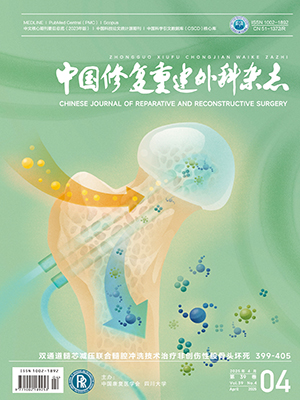| 1. |
李赞, 宋达疆. 肿瘤性复杂性胸壁缺损的修复策略及对肿瘤治疗的积极影响. 中华整形外科杂志, 2020, 36(3): 231-241.
|
| 2. |
Song D, Li J, Pafitanis G, et al. Bilateral anterolateral thigh myocutaneous flaps for giant complex chest wall reconstruction. Ann Plast Surg, 2021, 87(3): 298-309.
|
| 3. |
Song D, Liu D, Pafitanis G, et al. Extensive microsurgical reconstruction of chest wall defects for locally advanced breast cancer: A 10-year single-unit experience. Ann Plast Surg, 2020, 84(3): 293-299.
|
| 4. |
张世民, 宋达疆. 穿支皮瓣的发现发展历史与临床启示. 中国修复重建外科杂志, 2017, 31(7): 769-772.
|
| 5. |
宋达疆, 李赞, 周晓, 等. 胸壁肿瘤术后胸壁复杂缺损修复重建策略. 中华胸心血管外科杂志, 2017, 33(3): 164-167.
|
| 6. |
Banwell M, Trotter D, Ramakrishnan V. The thoracodorsal artery and vein as recipient vessels for microsurgical breast reconstruction. Ann Plast Surg, 2012, 68(5): 542-543.
|
| 7. |
Moran SL, Nava G, Behnam AB, et al. An outcome analysis comparing the thoracodorsal and internal mammary vessels as recipient sites for microvascular breast reconstruction: a prospective study of 100 patients. Plast Reconstr Surg, 2003, 111(6): 1876-1882.
|
| 8. |
Saint-Cyr M, Chang DW, Robb GL, et al. Internal mammary perforator recipient vessels for breast reconstruction using free TRAM, DIEP, and SIEA flaps. Plast Reconstr Surg, 2007, 120(7): 1769-1773.
|
| 9. |
Blondeel PN. One hundred free DIEP flap breast reconstructions: a personal experience. Br J Plast Surg, 1999, 52(2): 104-111.
|
| 10. |
宋达疆, 李赞, 周晓, 等. 同时携带肋间动脉穿支与腹壁下动脉穿支保留部分腹直肌的游离腹直肌皮瓣再造乳房. 中国修复重建外科杂志, 2021, 35(5): 605-610.
|
| 11. |
Hamdi M, Blondeel P, Van Landuyt K, et al. Algorithm in choosing recipient vessels for perforator free flap in breast reconstruction: the role of the internal mammary perforators. Br J Plast Surg, 2004, 57(3): 258-265.
|
| 12. |
Mackey SP, Ramsey KW. Exploring the myth of the valveless internal mammary vein-a cadaveric study. J Plast Reconstr Aesthet Surg, 2011, 64(9): 1174-1179.
|
| 13. |
Chavanon O, Romary B, Martin C, et al. Anatomical study of the internal thoracic arteries; implications for use in coronary artery bypass graft surgery. Surg Radiol Anat, 2016, 38(10): 1135-1142.
|
| 14. |
Rozen WM, Ye X, Guio-Aguilar PL, et al. Autologous microsurgical breast reconstruction and coronary artery bypass grafting: an anatomical study and clinical implications. Breast Cancer Res Treat, 2012, 134(1): 181-198.
|
| 15. |
Heitmann C, Guerra A, Metzinger SW, et al. The thoracodorsal artery perforator flap: anatomic basis and clinical application. Ann Plast Surg, 2003, 51(1): 23-29.
|
| 16. |
Kim JT. Two options for perforator flaps in the flank donor site: latissimus dorsi and thoracodorsal perforator flaps. Plast Reconstr Surg, 2005, 115(3): 755-763.
|




